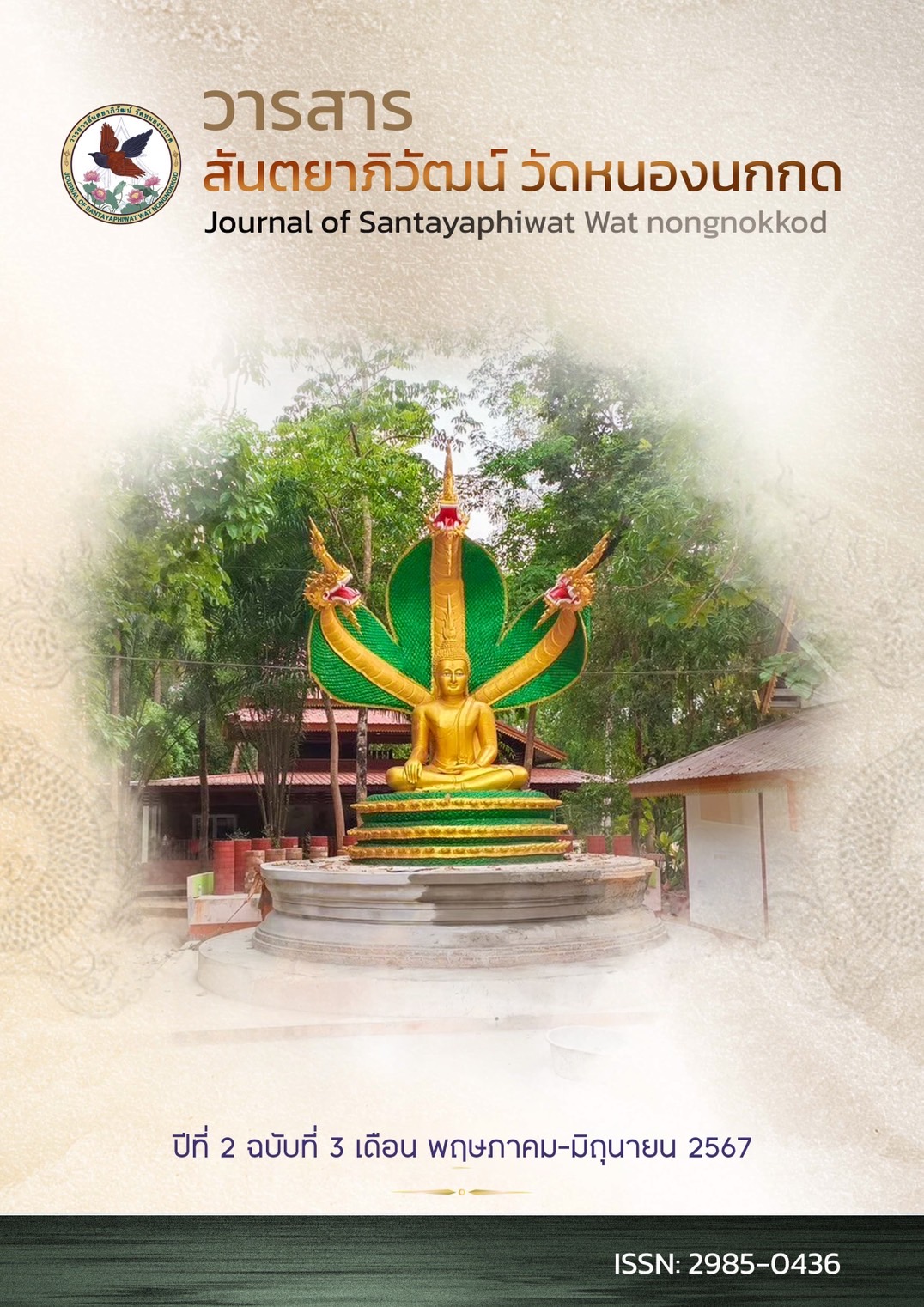DEVELOPING SKILLS IN READING AND WRITING BASIC THAI WORDS OF MATHAYOM 1 LEVEL USING THE THAI LANGUAGE LEARNING SKILLS MODEL
Keywords:
Reading skills, basic Thai words, learning skillsAbstract
The objectives of this research are (1) to develop academic achievement and the ability to develop basic Thai reading and writing skills in Mathayom 1 level between before and after school. Using skill training (2) to compare the results of the study of the effectiveness of the learning management plan for developing basic Thai reading and writing skills for Mathayom 1 level according to the 80/80 criterion. The target group used in this research is Mathayom 1 students at Phon Thong Prachasan School Nong Phan Tha Subdistrict So Phisai District Bueng Kan Province There are 20 people studying in the first semester of the academic year 2023. The research tools consist of 5 lesson plans using skill exercises, consisting of lesson plans about sounds in the Thai language. Complete with exercises about sounds in various languages and a test to measure achievement in learning to read and write basic Thai words, divided into a pre-study test and a post-study test, 20 questions each. Statistics used in the research include percentage (%), average, and section. Standard deviation and t-test In the case where the sample samples are not independent (t-test for dependent samples)
The results of the research found that (1) Mathayom 1 students had developed skills in reading and writing basic Thai words. Using skill exercises as a teaching media for reading and writing. This makes the score after studying higher than the score before studying. Statistically significant at the .05 level (2) Effectiveness and understanding in developing basic Thai reading and writing skills of Mathayom 1 students by teaching using skill exercises before and after the experiment. different and is effective according to the criteria set 80/80
References
กรมวิชาการ. (2544). คู่มือการจัดการเรียนรู้ กลุ่มสาระการเรียนรู้ภาษาไทย. กรุงเทพฯ : องค์การรับส่งสินค้า และพัสดุภัณฑ์.
กรมวิชาการ. (2546). หลักสูตรการศึกษาขั้นพื้นฐาน พุทธศักราช 2542 และที่แก้ไขเพิ่มเติม (ฉบับที่ 2) พุทธศักราช 2545. กรุงเทพฯ:องค์การรับส่งสินค้าและพัสดุภัณฑ์ (ร.ส.พ.).
กระทรวงศึกษาธิการ. (2551). หลักสูตรแกนกลางการศึกษาขั้นพื้นฐาน พุทธศักราช 2551. กรุงเทพฯ: โรงพิมพ์ชุมนุมสหกรณ์การเกษตรแห่งประเทศไทย จำกัด.
กรุณา ภูมรี. (2559). การพัฒนาแบบฝึกทักษะการเขียนสะกดคำยาก กลุ่มสาระการเรียนรู้ภาษาไทยชั้นประถมศึกษาปีที่ 1. (วิทยานิพนธ์ ครุศาสตรมหาบัณฑิต สาขาวิชาหลักสูตรและการสอน, มหาวิทยาลัยราชภุฏอุบลราชธานี).
ประวีณา เอ็นดู. (2547). การพัฒนาแผนการจัดการเรียนรู้ภาษาไทย เรื่อง การอ่านและการเขียนสะกดคำโดยใช้แบบฝึกทักษะ ชั้นประถมศึกษาปีที่ 1. การศึกษาค้นคว้าอิสระ กศ.ม. มหาสารคาม : มหาวิทยาลัยมหาสารคาม.
พนมวัน วรดลย์. (2542). การสร้างแบบฝึกการเขียนสะกดคำของนักเรียนประถมศึกษาปีที่ 2. การค้นคว้าอิสระ ปริญญาครุศาสตรมหาบัณฑิต บัณฑิตวิทยาลัย มหาวิทยาลัยศรนครินทรวิโรฒประสานมิตร.
วรัญญา ไวบรรเทา และอุษาพร เสวกวิ. (2563). การจัดการเรียนรู้โดยใช้นิทานเพื่อพัฒนาทักษะการอ่านคำศัพท์ภาษาไทยของนักเรียนชั้นประถมศึกษาปีที่ 1. วารสารศึกษาศาสตร์ มมร. 8(1), 230-240.
วิมลรัตน์ สุนทรโรจน์. (2549). นวัตกรรมตามแนวคิด Backward Design. ภาควิชาหลักสูตรและการสอน คณะศึกษาศาสตร์ มหาวิทยาลัยมหาสารคาม.
วิเศษ แปวไธสง. 2547. การพัฒนาแผนการจัดการเรียนรู้และแบบฝึกทักษะประกอบการเรียน กลุ่มสาระการเรียนรู้ภาษาไทยแบบมุ่งประสบการณ์ภาษา เรื่อง ลูกอ๊อดหาแม่ชั้นประถมศึกษาปีที่ 2. การศึกษาค้นคว้าอิสระ กศ.ม. มหาสารคาม: มหาวิทยาลัยมหาสารคาม.
Garcia, Carol Ann. (1998). “The Effect of Two Types of Spilling Instruction on First – grade Reading, Writing, and Spelling Achievemint.” Dissertation Abstracts international.








